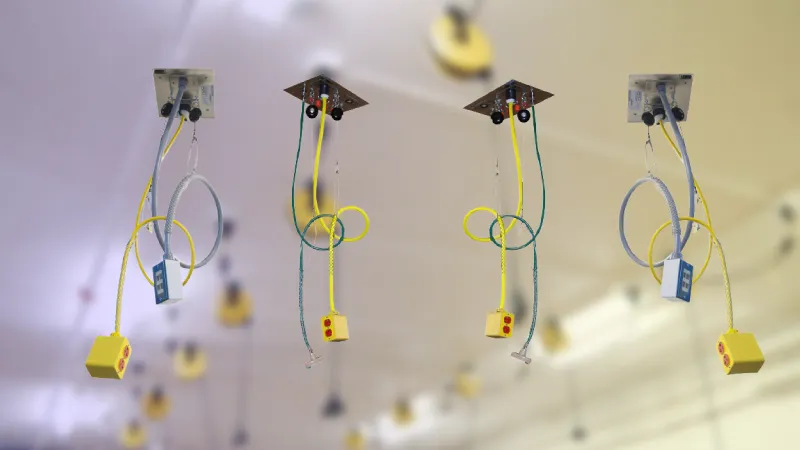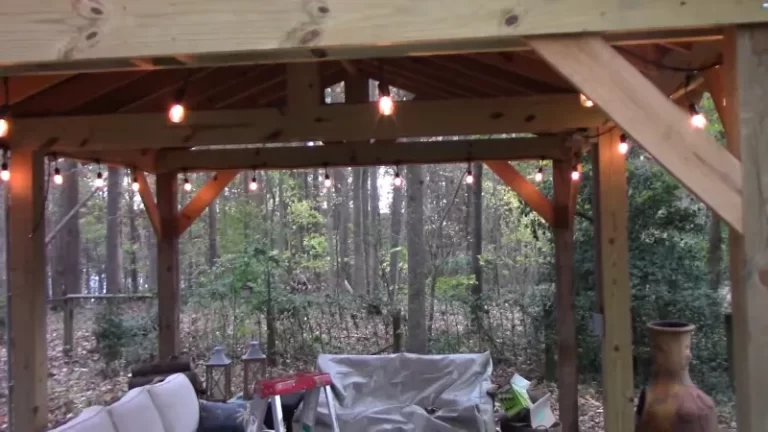Power Cord Drop From Ceiling Guide

A power cord drop from ceiling is a permanent electrical installation that provides power to a specific area or device in a commercial space. It consists of a conduit, wiring, and outlets that are installed in the ceiling and drop down to the desired location.
Power cord drops are an effective and safe way to power multiple devices in a commercial setting, as they are installed in accordance with electrical codes and standards to ensure safety. Proper installation and use of power cord drops is essential for maintaining electrical safety in commercial spaces, as it helps to prevent hazards such as electrical fires and shocks.
You'll Learn About
Power Cord Drop From Ceiling
It is generally not safe or code-compliant to use extension cords as a permanent wiring solution, especially in a commercial setting. Extension cords are designed for temporary use and are not meant to be used as a substitute for permanent wiring. They should not be affixed to structures, extended through walls, ceilings, or floors, or subject to environmental damage or physical impact.
If you need to provide power to a specific area or device in your commercial space, it is recommended to have a licensed electrician install a permanent electrical drop with appropriate conduit, wiring, and outlets. The electrical drop should be installed in accordance with all applicable electrical codes and standards, including the National Electrical Code (NEC) and any local codes.
It is important to follow proper electrical safety practices when installing any electrical components, including electrical drops. If you are not familiar with electrical work, it is recommended to consult a licensed electrician for assistance.
What is a Power Cord Drop From Ceiling?
A power cord drop from ceiling is a permanent electrical installation that provides power to a specific area or device in a commercial space. It consists of a conduit, wiring, and outlets that are installed in the ceiling and drop down to the desired location. The purpose of a power cord drop is to provide a safe and reliable source of power to a specific area or device, without the need for extension cords or other temporary wiring solutions.
Power cord drops are designed for use in commercial spaces, such as factories, warehouses, and offices. They are typically used to power machines, equipment, or other devices that require a consistent and stable source of electricity.
Power cord drops are an alternative to extension cords, which are designed for temporary use and are not meant to be used as a permanent wiring solution. Extension cords should not be affixed to structures, extended through walls, ceilings, or floors, or subject to environmental damage or physical impact.
Can You Run Power Cord in Drop Ceiling?
No, Running Power Cord in Drop Ceiling Prohibited by NEC
According to the National Electric Code (NEC) Section 400.8, it is prohibited to route a cord through a drop or suspended ceiling. This means that power cords should not be run through holes or gaps in the ceiling structure, even if the components are assembled or packaged at the manufacturing facility.
This rule is in place to ensure the safety of electrical systems and to prevent any potential hazards such as electrical shock, fire, or other accidents. It is important to follow these regulations to ensure a safe and compliant electrical installation.
Benefits of Power Cord Drops
There are several benefits to using power cord drops in a commercial setting:
Neat and Organized Appearance
Power cord drops are installed in the ceiling and are not visible, which helps to maintain a neat and organized appearance in your commercial space. This is especially important in areas where there may be a lot of foot traffic or where appearance is a concern, such as in an office setting.
Safe and Code-compliant Installation
Power cord drops are installed in accordance with electrical codes and standards, which helps to ensure safety and compliance. Proper installation of a power cord drop minimizes the risk of electrical fires and shocks, and helps to prevent other hazards.
Ability to Power Multiple Devices
Power cord drops can provide power to multiple devices at once, which is useful in situations where you need to power multiple machines or equipment in a specific area. This can help to reduce the need for multiple extension cords or outlets, which can be cluttered and unsafe.
Overall, power cord drops are a safe, code-compliant, and convenient solution for providing power to multiple devices in a commercial setting.
How to Install a Power Cord Drop From Ceiling
To install a power cord drop from ceiling, you will need to follow these steps:
Plan and Prepare for Installation
Before you start installing a power cord drop, it is important to plan and prepare for the installation. This includes determining the route that the power cord will take, identifying any obstacles or challenges that may arise, and gathering the necessary materials and tools.
- Gather materials and tools: You will need a variety of materials and tools to install a power cord drop, including conduit, wiring, outlets, a drill, a saw, wire strippers, wire connectors, and a voltage tester.
- Mark the ceiling tiles: Once you have determined the route that the power cord will take, mark the ceiling tiles where the wire will enter and exit.
- Install the conduit: Use a drill to create holes in the marked ceiling tiles, and then attach the conduit to the holes using screws or clips.
- Run the wiring: Feed the wiring through the conduit and connect it to the outlets at either end of the power cord drop.
- Install the outlets: Attach the outlets to the conduit at either end of the power cord drop, making sure to use appropriate wire connectors to secure the connections.
- Test the power cord drop: Use a voltage tester to ensure that the power cord drop is functioning properly and that there are no loose connections.
Some tips and best practices to follow when installing a power cord drop include:
- Always follow electrical codes and standards to ensure safety and compliance.
- Consult a licensed electrician if you are not familiar with electrical work or if you encounter any challenges during the installation.
- Secure the conduit and wiring to prevent them from being damaged or dislodged.
- Use appropriate wire connectors and other materials to ensure proper connections and prevent hazards.
- Test the power cord drop after installation to ensure that it is functioning properly.
Electrical Code Considerations
It is important to follow electrical codes and standards when installing a power cord drop in a commercial setting. Electrical codes are designed to ensure the safety of electrical installations and to prevent hazards such as electrical fires and shocks.
The National Electrical Code (NEC) is a set of guidelines and standards for electrical installations in the United States. The NEC includes requirements for power cord drops, including the types of cord and conduit that can be used, the spacing and placement of outlets, and the methods of installation. Some of the NEC requirements for power cord drops include:
- Cord drops must be properly supported to prevent damage and ensure safety.
- Cord drops must be installed in accordance with the manufacturer’s instructions and any applicable codes.
- Cord drops must be installed in an accessible location.
- Cord drops must be protected from physical damage and environmental hazards.
In addition to the NEC requirements, it is also important to consider any local code requirements that may apply to your specific location. Local codes may have additional requirements or guidelines for electrical installations, so it is important to check with your local building department or electrical inspection agency to ensure that your power cord drop installation meets all applicable codes and standards.
Overall, it is essential to follow all applicable electrical codes and standards when installing a power cord drop in a commercial setting to ensure safety and compliance.
Conclusion
In conclusion, power cord drops are a safe and effective solution for providing power to specific areas or devices in a commercial setting. They offer a neat and organized appearance, are installed in accordance with electrical codes and standards to ensure safety, and can power multiple devices at once.
When installing a power cord drop, it is important to plan and prepare for the installation, gather the necessary materials and tools, and follow all applicable codes and standards. If you are not familiar with electrical work, it is recommended to consult a licensed electrician for assistance.
It is also important to remember the importance of electrical safety and to follow proper electrical safety practices at all times.


